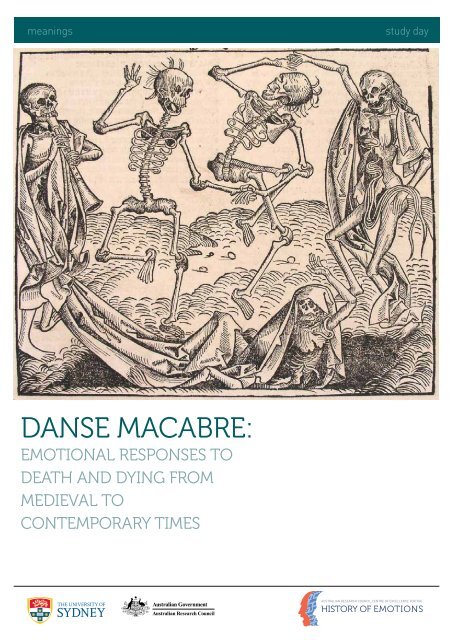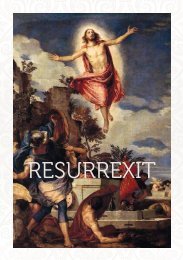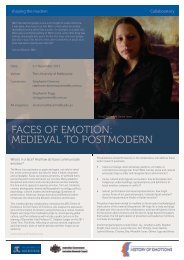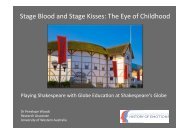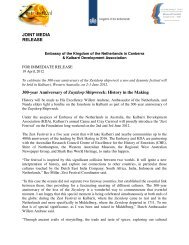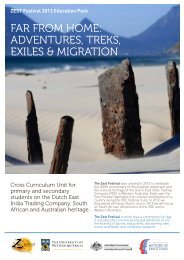Danse Macabre: - ARC Centre of Excellence for the History of Emotion
Danse Macabre: - ARC Centre of Excellence for the History of Emotion
Danse Macabre: - ARC Centre of Excellence for the History of Emotion
Create successful ePaper yourself
Turn your PDF publications into a flip-book with our unique Google optimized e-Paper software.
meanings<br />
study day<br />
<strong>Danse</strong> <strong>Macabre</strong>:<br />
<strong>Emotion</strong>al Responses to<br />
Death and Dying from<br />
Medieval to<br />
Contemporary Times
Acknowledgements<br />
Dr Juanita Feros Ruys (Convenor) would like to thank <strong>the</strong> following<br />
people and acknowledge <strong>the</strong>ir support in <strong>the</strong> organisation <strong>of</strong> this<br />
Study Day:<br />
• Australian Research Council, <strong>Centre</strong> <strong>of</strong> <strong>Excellence</strong> <strong>for</strong> <strong>the</strong><br />
<strong>History</strong> <strong>of</strong> <strong>Emotion</strong>s (CHE)<br />
• Pr<strong>of</strong>essor Duncan Ivison, Dean <strong>of</strong> Arts and Social Sciences,<br />
The University <strong>of</strong> Sydney<br />
• Ms Erika von Kaschke, National Communications Officer, <strong>ARC</strong><br />
<strong>Centre</strong> <strong>of</strong> <strong>Excellence</strong> <strong>for</strong> <strong>the</strong> <strong>History</strong> <strong>of</strong> <strong>Emotion</strong>s<br />
• Ms Mairead McHugh, Event Manager, Restaurant Associates,<br />
Australian Museum<br />
• Ms Priscilla Gundelach, Administration Officer, <strong>ARC</strong> <strong>Centre</strong> <strong>for</strong><br />
<strong>the</strong> <strong>History</strong> <strong>of</strong> <strong>Emotion</strong>s at The University <strong>of</strong> Sydney<br />
Cover image: Michael Wolgemut, <strong>Danse</strong> <strong>Macabre</strong>, 1493. Wikipedia Commons<br />
<strong>Emotion</strong>s<br />
Make<br />
<strong>History</strong>
meanings<br />
study day<br />
The <strong>ARC</strong> <strong>Centre</strong> <strong>of</strong> <strong>Excellence</strong> <strong>for</strong> <strong>the</strong><br />
<strong>History</strong> <strong>of</strong> <strong>Emotion</strong>s (Europe 1100-1800) presents:<br />
<strong>Danse</strong> <strong>Macabre</strong>:<br />
<strong>Emotion</strong>al Responses<br />
to Death and Dying<br />
from Medieval to<br />
Contemporary Times<br />
Date: Friday 21 September 2012<br />
Time: 09:00 am - 6.00 pm<br />
Venue: Australian Museum<br />
6 College Street, Sydney<br />
Convenor: Dr Juanita Feros Ruys<br />
juanita.ruys@sydney.edu.au<br />
TIME<br />
SPEAKERS<br />
9.00 – 9.05 Welcome: Dr Juanita Feros Ruys (<strong>ARC</strong> <strong>Centre</strong> <strong>of</strong> <strong>Excellence</strong> <strong>for</strong> <strong>the</strong> <strong>History</strong> <strong>of</strong> <strong>Emotion</strong>s/ The University <strong>of</strong> Sydney)<br />
9.05-9.10 Introductory Address: Pr<strong>of</strong>essor Duncan Ivison (Dean, Faculty <strong>of</strong> Arts and Social Sciences, The University <strong>of</strong> Sydney)<br />
9.10 - 9.55 Keynote Address: Pr<strong>of</strong>essor Ian Hickie (Brain and Mind Research Institute, The University <strong>of</strong> Sydney)<br />
9.55 - 10.10 Discussion<br />
10.10 - 10.30 MORNING TEA<br />
10.30 – 11.05 Dr Rebecca McNamara (The University <strong>of</strong> Sydney): The Sorrow <strong>of</strong> Soreness: Infirmity and Suicide in <strong>the</strong> Middle Ages<br />
11.05 – 11.40 Dr Eric Parisot (The University <strong>of</strong> Queensland): Suicide Notes and Popular Sensibility in Eighteenth-Century Press<br />
11.40 – 12.15 Associate Pr<strong>of</strong>essor Carole M. Cusack (The University <strong>of</strong> Sydney): Individual Suicide and <strong>the</strong> Eschaton: Destruction and<br />
Trans<strong>for</strong>mation in UFO and Alien-Based Religions<br />
12.15–1.00 LUNCH<br />
1.00 – 1.20 Dr Peter Goldsworthy: Introduction to and screening <strong>of</strong> film adaptation <strong>of</strong> Dr Goldsworthy’s short story, The Kiss (directed by<br />
Ashlee Page)<br />
1.20 – 1.30 Discussion<br />
1.30 - 2.00 Keynote Address: Dr Peter Goldsworthy: Death and <strong>the</strong> Comedian: Black Humour and Blacker Tragedy in <strong>the</strong> Work <strong>of</strong> Doctors<br />
Who Write<br />
2.00 - 2.10 Discussion<br />
2.10 - 2.20 BREAK<br />
2.20 - 2.55 Dr Una McIlvenna (The University <strong>of</strong> Sydney): Singing <strong>the</strong> News <strong>of</strong> Death: Execution Ballads in Early Modern Europe<br />
2.55 – 3.30 Dr Dosia Reichardt (James Cook University, Cairns): “Good Sack and Claret Tears”: How Not to Mourn in Seventeenth-<br />
Century Elegy<br />
3.30–3.45 AFTERNOON TEA<br />
3.45 – 4.20 Dr Jennifer McDonell (The University <strong>of</strong> New England): Mourning <strong>the</strong> Animal Dead: Sentimentality and <strong>the</strong> Care Tradition in<br />
Animal Ethics<br />
4.20 – 4.55 Ms Zoe Alderton (The University <strong>of</strong> Sydney): Favouring <strong>the</strong> Dead: Juan Manuel Echavarría’s “Requiem NN”<br />
4.55 - 5.00 Discussion and close<br />
5.00 – 6.00 POST-CONFERENCE DRINKS - Skeleton Gallery
abstracts<br />
Ms Zoe Alderton<br />
(University <strong>of</strong> Sydney)<br />
Favouring <strong>the</strong> Dead: Juan Manuel Echavarría’s Requiem NN<br />
Commencing with an historical examination <strong>of</strong> conflict in<br />
Colombia, I will establish <strong>the</strong> political circumstances that have<br />
lead to social upheaval in <strong>the</strong> region. By means <strong>of</strong> contrast, I<br />
will also explore <strong>the</strong> tenderness and reciprocal generosity at<br />
play within Puerto Berrío’s cemetery. Echavarría believes that<br />
Colombia is experiencing compassion fatigue after decades <strong>of</strong><br />
sensationalist media and <strong>the</strong> normalisation <strong>of</strong> human slaughter.<br />
Death has become commonplace. By caring <strong>for</strong> strangers—<br />
whose bodies would have o<strong>the</strong>rwise been consumed by fish<br />
and vultures—<strong>the</strong> people <strong>of</strong> Puerto Berrío ritualise <strong>the</strong><br />
importance and dignity <strong>of</strong> <strong>the</strong> individual. They also bring<br />
toge<strong>the</strong>r <strong>the</strong>ir threatened community in a time <strong>of</strong> civil disarray.<br />
I will conclude this presentation with a discussion <strong>of</strong> <strong>the</strong><br />
differences between Colombian and Australian cultures in<br />
terms <strong>of</strong> <strong>the</strong> anonymous dead and <strong>the</strong> politics <strong>of</strong> representation<br />
and memorialisation.<br />
Dr Peter Goldsworthy<br />
Death and <strong>the</strong> Comedian: Black Humour and Blacker Tragedy<br />
in <strong>the</strong> Work <strong>of</strong> Doctors Who Write<br />
The best education <strong>for</strong> a writer is a medical degree according to<br />
Somerset Maugham, but perhaps <strong>the</strong> best (self-) treatment <strong>for</strong> <strong>the</strong><br />
stresses <strong>of</strong> medical practice is writing.<br />
Peter Goldsworthy will talk about his own experiences as a<br />
doctor/writer, also touching on <strong>the</strong> work <strong>of</strong> o<strong>the</strong>rs such as Anton<br />
Chekhov, Gottfried Benn, Alfred Döblin and François Rabelais.<br />
Peter’s address will be preceeded by a screening <strong>of</strong> <strong>the</strong><br />
breathtaking short film <strong>of</strong> his darkly erotic story, “The Kiss”,<br />
directed by Ashlee Page.<br />
Pr<strong>of</strong>essor Ian Hickie<br />
(Brain and Mind Research Institute, The University <strong>of</strong> Sydney)<br />
Keynote Address<br />
Associate Pr<strong>of</strong>essor Carole M. Cusack<br />
(The University <strong>of</strong> Sydney)<br />
Individual Suicide and <strong>the</strong> Eschaton: Destruction and<br />
Trans<strong>for</strong>mation in UFO and Alien-Based Religions<br />
UFO and alien-based religions emerged in <strong>the</strong> wake <strong>of</strong> World<br />
War II, drawing upon both <strong>the</strong> hardware-oriented protoconspiracist<br />
sightings <strong>of</strong> Kenneth Arnold and <strong>the</strong> Roswell<br />
Incident (both 1947) and <strong>the</strong> Theosophical notion <strong>of</strong> Ascended<br />
Masters which was extended to include extra-terrestrials (in<br />
addition to <strong>the</strong> dead, Tibetan lamas, and o<strong>the</strong>r putative sources<br />
<strong>of</strong> wisdom). This potent mixture was married to <strong>the</strong> popular<br />
cultural narratives <strong>of</strong> science fiction, such as <strong>the</strong> influential<br />
‘alien messiah’ film The Day <strong>the</strong> Earth Stood Still (1951).<br />
The <strong>the</strong>mes <strong>of</strong> apocalypse and <strong>the</strong> conspiracy were particularly<br />
congruent with <strong>the</strong> Cold War atmosphere <strong>of</strong> paranoia and<br />
scape-goating. UFO and alien-based religions developed in<br />
divergent directions, with some advocating an eschaton <strong>of</strong><br />
battle and destruction (such as <strong>the</strong> Church Universal and<br />
Triumphant), o<strong>the</strong>rs envisaging an harmonious Intergalactic<br />
Parliament in which humans participated in peace (such as <strong>the</strong><br />
Ae<strong>the</strong>rius Society), and, most notoriously, thirty-nine members<br />
<strong>of</strong> Heaven’s Gate (founded by Marshall Herff Applewhite and<br />
Bonnie Lu Nettles) committing mass suicide on 26 March 1997<br />
in order to transition to <strong>the</strong> ‘next level’.<br />
This paper examines <strong>the</strong> apocalyptic expectations <strong>of</strong> UFO and<br />
alien-based religions, chiefly Heaven’s Gate, to demonstrate<br />
that individual suicide is generally <strong>for</strong>mulated as transitioning<br />
to <strong>the</strong> ‘next level’ ra<strong>the</strong>r than <strong>the</strong> negative action <strong>of</strong> destroying<br />
<strong>the</strong> human body in this life (<strong>for</strong> example, Heaven’s Gate was<br />
opposed to suicide per se, but redefined it as ‘to turn against<br />
<strong>the</strong> Next Level when it is being <strong>of</strong>fered’ and claimed that <strong>the</strong>ir<br />
human bodies were mere ‘vessels’ and ‘vehicles’), and that <strong>the</strong><br />
destruction <strong>of</strong> <strong>the</strong> planet Earth (or even <strong>the</strong> universe) is similarly<br />
understood to be an essentially positive trans<strong>for</strong>mation that<br />
births a new world. Thus <strong>the</strong> two phenomena are identical with<br />
each o<strong>the</strong>r in a microcosm/macrocosm relationship.<br />
Dr Jennifer McDonell<br />
(The University <strong>of</strong> New England)<br />
Mourning <strong>the</strong> Animal Dead: Sentimentality and <strong>the</strong> Care<br />
Tradition in Animal Ethics<br />
For whom is it proper to mourn This paper addresses a<br />
ubiquitous and largely occluded dimension <strong>of</strong> interspecies<br />
cultural history, representations <strong>of</strong> bereavement upon <strong>the</strong> loss <strong>of</strong><br />
companion animals. Drawing on a range <strong>of</strong> writings from <strong>the</strong><br />
nineteenth-century onwards, <strong>the</strong> paper examines a paradox at<br />
<strong>the</strong> heart <strong>of</strong> human responses towards <strong>the</strong> death <strong>of</strong> that most<br />
popular <strong>of</strong> domestic animals, <strong>the</strong> dog: humanisation and<br />
disposability. While many millions <strong>of</strong> healthy dogs are euthanised<br />
in pet shelters in western countries each year, <strong>the</strong> act <strong>of</strong><br />
mourning <strong>for</strong> individual dogs is a pr<strong>of</strong>oundly conflicted experience<br />
<strong>for</strong> many bereaved subjects.<br />
My research into cross-species companionship in nineteenthcentury<br />
England suggests that <strong>the</strong> expression <strong>of</strong> grief by women<br />
writers, in particular, upon <strong>the</strong> death <strong>of</strong> <strong>the</strong>ir dogs was not only<br />
routinely dismissed by <strong>the</strong>ir contemporaries as sentimental, as<br />
‘inordinate affection’ (to use <strong>the</strong> title <strong>of</strong> a book on bereavement<br />
<strong>for</strong> dogs by composer and suffragist E<strong>the</strong>l Smyth), but was <strong>of</strong>ten<br />
perceived to be a threat to ‘legitimate’ emotional, ethical, and<br />
political attachments to family, human animals and nation.<br />
Attention to case-sensitive, situated accounts <strong>of</strong> mourning <strong>for</strong><br />
ano<strong>the</strong>r species discloses a more nuanced vocabulary <strong>of</strong> feeling<br />
as a resource <strong>for</strong> an ethics <strong>of</strong> care towards animals. Central to<br />
this investigation is <strong>the</strong> imperative to understand why <strong>the</strong><br />
structure <strong>of</strong> feeling that came in <strong>the</strong> nineteenth-century to be<br />
identified as sentimentality was (and still is) used to devalue<br />
representational regimes which position animals as<br />
communicative agents who possess recognisable interests or<br />
evoke sympa<strong>the</strong>tic identification. Finally <strong>the</strong> paper suggests that<br />
<strong>the</strong> kind <strong>of</strong> anthropomorphic sentimentality that turns pets into<br />
objects <strong>for</strong> human emotional consumption is a doubling <strong>of</strong> <strong>the</strong><br />
instrumentalism that also allows <strong>the</strong>m to die en masse,<br />
unmourned.
abstracts<br />
Dr Una McIlvenna<br />
(The University <strong>of</strong> Sydney)<br />
Singing <strong>the</strong> News <strong>of</strong> Death: Execution Ballads in Early Modern<br />
Europe<br />
Across early modern Europe, accounts <strong>of</strong> crimes and executions<br />
were printed on cheap pamphlets in ballad <strong>for</strong>m, usually set to a<br />
well-known tune. Often written in <strong>the</strong> voice <strong>of</strong> <strong>the</strong> condemned,<br />
<strong>the</strong>se ‘dying-man’s speeches’ allowed <strong>the</strong> spectators at an<br />
execution (and those who listened to <strong>the</strong> ballad afterwards) <strong>the</strong><br />
opportunity to rejoice at <strong>the</strong> punishment <strong>of</strong> crimes, but also to<br />
engage with <strong>the</strong> potential repentance and last moments <strong>of</strong> <strong>the</strong><br />
condemned.<br />
This paper not only explores <strong>the</strong> popularity <strong>of</strong> execution ballads but<br />
also demonstrates how singing about death is different to writing<br />
and reading about it. These songs were invariably moralizing but<br />
could also be joyous, and some were even set to dance tunes.<br />
Execution ballads, <strong>the</strong>re<strong>for</strong>e, <strong>of</strong>fer a uniquely useful means <strong>of</strong><br />
understanding <strong>the</strong> communal, per<strong>for</strong>mative nature <strong>of</strong> death and<br />
dying in <strong>the</strong> early modern period.<br />
Dr Rebecca McNamara<br />
(The University <strong>of</strong> Sydney)<br />
The Sorrow <strong>of</strong> Soreness: Infirmity and Suicide in <strong>the</strong> Middle<br />
Ages<br />
Based on a study <strong>of</strong> suicide cases in medieval European legal<br />
records, this paper will present <strong>the</strong> relationship seen between<br />
physical and mental infirmity and <strong>the</strong> emotions <strong>of</strong> <strong>the</strong> selfmurdered.<br />
Examples <strong>of</strong> suicides and attempted suicides depicted<br />
in art, literature, and saints’ miracles during <strong>the</strong> same period will<br />
<strong>for</strong>m an illuminating cultural context <strong>for</strong> <strong>the</strong> recorded deaths <strong>of</strong><br />
actual persons. Moreover, <strong>the</strong> responses <strong>of</strong> family, community,<br />
and <strong>the</strong> judiciary will be considered as we ask ‘how did people<br />
respond to suicide in <strong>the</strong> Middle Ages’<br />
Dr Eric Parisot<br />
(University <strong>of</strong> Queensland)<br />
Suicide Notes and Popular Sensibility in Eighteenth-Century<br />
Press<br />
By <strong>the</strong> mid-eighteenth century, <strong>the</strong> published suicide note had<br />
emerged in Britain as a powerful literary tool in <strong>the</strong> secularization<br />
<strong>of</strong> self-murder, and an absolute boon <strong>for</strong> print media. As a final<br />
means <strong>of</strong> self-expression, <strong>the</strong> increasing publication <strong>of</strong> such notes<br />
and letters in <strong>the</strong> popular press af<strong>for</strong>ded suicides <strong>the</strong> opportunity<br />
to influence <strong>the</strong> way not only loved ones responded to <strong>the</strong>ir death,<br />
but also a readership <strong>of</strong> strangers. Often written with a public<br />
audience in mind, such notes became a means to win attention, to<br />
gain sympathy, to preserve reputation, to absolve and justify, to<br />
seek revenge, or even to serve as moral caution. While <strong>the</strong> rise <strong>of</strong><br />
printed suicide notes in eighteenth-century newspapers and<br />
magazines has been charted to some degree by social<br />
historians, <strong>the</strong>ir cumulative influence upon contemporary<br />
models <strong>of</strong> sensibility and sentimentalism has been largely<br />
unexplored. My presentation will draw upon examples <strong>of</strong><br />
printed suicide notes to examine <strong>the</strong> rhetoric and hermeneutics<br />
<strong>of</strong> suicide writing and <strong>the</strong>ir connection to contemporary<br />
<strong>the</strong>ories <strong>of</strong> sensibility. In doing so, one is able to articulate <strong>the</strong><br />
increasing recognition <strong>of</strong> suicide as <strong>the</strong> darker and more<br />
extreme manifestation <strong>of</strong> a refined faculty <strong>of</strong> feeling, and <strong>the</strong><br />
incipient dangers <strong>of</strong> publishing and disseminating such <strong>for</strong>ms<br />
<strong>of</strong> writing.<br />
Dr Dosia Reichardt<br />
(James Cook University, Cairns)<br />
‘Good Sack and Claret Tears’: How Not to Mourn in<br />
Seventeenth-Century Elegy<br />
The culture <strong>of</strong> early modern mourning finds copious expression<br />
in funeral elegies and epitaphs - a genre which dominated<br />
poetry in <strong>the</strong> mid-seventeenth-century, but alongside<br />
conventional laments <strong>the</strong>re are many mock encomia which<br />
<strong>for</strong>m a hi<strong>the</strong>rto neglected mirror image <strong>for</strong> classically inspired<br />
expressions <strong>of</strong> grief. Seventeenth-century manuscript<br />
miscellanies <strong>of</strong>ten juxtapose mock elegies <strong>for</strong> inanimate<br />
objects or comic epitaphs on tradesmen with laments <strong>for</strong> dead<br />
children and with classical elegies <strong>for</strong> public figures. By<br />
following <strong>the</strong> accepted design <strong>of</strong> praise, lament, consolation,<br />
and exhortation sprinkled with classical allusion, but by<br />
addressing unusual or indecorous topics, comic funereal verse<br />
shows how <strong>the</strong> conventions <strong>of</strong> classical elegy in fact provide a<br />
useful escape from any real expression <strong>of</strong> grief.<br />
Historians and cultural <strong>the</strong>orists have examined <strong>the</strong> changing<br />
practices and attitudes associated with death and dying in this<br />
period, while literary critics have looked at <strong>the</strong> response <strong>of</strong> <strong>the</strong><br />
living to <strong>the</strong> dead principally through <strong>the</strong> writings <strong>of</strong>, or on,<br />
canonical poets. Despite <strong>the</strong> range and volume <strong>of</strong> this<br />
secondary literature, however, it has not examined comic<br />
responses to death (and has mostly even failed to mention<br />
such attitudes), nor included humour as an integral part <strong>of</strong> <strong>the</strong><br />
symbolic work <strong>of</strong> mourning that trans<strong>for</strong>ms loss into cultural<br />
capital. My researches indicate that ‘comic elegies’ (as <strong>the</strong><br />
most useful blanket tool) could be used to diffuse a wide range<br />
<strong>of</strong> emotions including social unease about <strong>the</strong> rise <strong>of</strong> a middle<br />
class, <strong>the</strong> sexuality <strong>of</strong> powerful women, and political impotence.<br />
They also record and express a surprisingly indecorous<br />
curiosity about unusual deaths. Verses on falling from hayricks<br />
or ‘On one Drowned in <strong>the</strong> Snow’ were popular.<br />
For this brief talk I will focus on some poems by Thomas<br />
Randolph. Randolph wrote a number <strong>of</strong> mock elegies whose<br />
popularity in manuscript lasted posthumously <strong>for</strong> several<br />
decades, and which were ‘revived’ when miscellanies and<br />
drolleries with an anti-Puritan bias began to be published in<br />
<strong>the</strong> Interregnum.
speakers at <strong>the</strong> symposium speakers<br />
Ms Zoe Alderton is a PhD<br />
candidate and research assistant in<br />
<strong>the</strong> Department <strong>of</strong> Studies in<br />
Religion at <strong>the</strong> University <strong>of</strong> Sydney.<br />
Her <strong>the</strong>sis investigates <strong>the</strong><br />
Christian symbols <strong>of</strong> Colin<br />
McCahon, New Zealand’s<br />
preeminent modern painter. This<br />
research focuses on <strong>the</strong> schism<br />
between <strong>the</strong> artist’s intent and audience reception, which is<br />
reflective <strong>of</strong> socio-cultural trends in New Zealand.<br />
Zoe is tutor <strong>for</strong> a course on a<strong>the</strong>ism, fundamentalism, and<br />
new religions in <strong>the</strong> Department <strong>of</strong> Studies in Religion, and<br />
tutor <strong>for</strong> a course on rhetoric and academic essay styles <strong>for</strong><br />
The University <strong>of</strong> Sydney Writing Hub. Zoe has published<br />
journal articles on <strong>the</strong> music <strong>of</strong> Nick Cave, outsider artist<br />
Norbert Kox, politics concerning <strong>the</strong> Blake Prize <strong>for</strong> Religious<br />
Art, and Theosophical discourses in <strong>the</strong> modern art <strong>of</strong> Sydney.<br />
She is reviews editor <strong>for</strong> <strong>the</strong> journal Literature & Aes<strong>the</strong>tics,<br />
and her <strong>for</strong>thcoming publications concern <strong>the</strong> religiosity <strong>of</strong><br />
Colin McCahon and his Muriwai paintings.<br />
Dr Carole M. Cusack is Associate<br />
Pr<strong>of</strong>essor in Studies in Religion at<br />
The University <strong>of</strong> Sydney. She trained<br />
as a medievalist and her doctorate<br />
was published as Conversion Among<br />
<strong>the</strong> Germanic Peoples (Cassell, 1998).<br />
Since <strong>the</strong> late 1990s she has taught in<br />
contemporary religious trends,<br />
publishing on pilgrimage and<br />
tourism, modern Pagan religions,<br />
new religious movements, <strong>the</strong> interface between religion and<br />
politics, and religion and popular culture. She is <strong>the</strong> author <strong>of</strong><br />
The Essence <strong>of</strong> Buddhism (Lansdowne, 2001), Invented<br />
Religions: Imagination, Fiction and Faith (Ashgate, 2010), and The<br />
Sacred Tree: Ancient and Medieval Manifestations (Cambridge<br />
Scholars Publishing, 2011).<br />
She has published a number <strong>of</strong> edited volumes, including (with<br />
Christopher Hartney) Religion and Retributive Logic: Essays in<br />
Honour <strong>of</strong> Garry W. Trompf (Brill, 2010) and (with Alex Norman)<br />
<strong>the</strong> Handbook <strong>of</strong> New Religions and Cultural Production (2012).<br />
With Christopher Hartney (The University <strong>of</strong> Sydney) she is<br />
editor <strong>of</strong> <strong>the</strong> Journal <strong>of</strong> Religious <strong>History</strong> (Wiley) and with Liselotte<br />
Frisk (Dalarna University) she is editor <strong>of</strong> <strong>the</strong> International<br />
Journal <strong>for</strong> <strong>the</strong> Study <strong>of</strong> New Religions (Equinox). She serves on<br />
<strong>the</strong> Editorial Boards <strong>of</strong> <strong>the</strong> journal Literature & Aes<strong>the</strong>tics, <strong>the</strong><br />
Sacred and Secular Histories Series (Palgrave Macmillan) and<br />
<strong>the</strong> Sophia Monograph Series (Springer).<br />
Study Day Convenor: Dr<br />
Juanita Feros Ruys is an <strong>ARC</strong><br />
QEII Senior Research Fellow and<br />
Associate Director <strong>of</strong> <strong>the</strong> Medieval<br />
and Early Modern <strong>Centre</strong>, The<br />
University <strong>of</strong> Sydney, and a Chief<br />
Investigator at <strong>the</strong> <strong>ARC</strong> <strong>Centre</strong> <strong>of</strong><br />
<strong>Excellence</strong> <strong>for</strong> <strong>the</strong> <strong>History</strong> <strong>of</strong> <strong>Emotion</strong>s<br />
(CHE). She is researching and<br />
overseeing research on a number <strong>of</strong><br />
projects <strong>for</strong> <strong>the</strong> CHE including <strong>the</strong> emotional states associated<br />
with <strong>the</strong> suicidal impulse in <strong>the</strong> Middle Ages, <strong>the</strong> attribution <strong>of</strong><br />
emotions to demons in <strong>the</strong> scholastic Middle Ages, and <strong>the</strong><br />
nexus between love and sex in <strong>the</strong> Middle Ages. Her previous<br />
areas <strong>of</strong> research include medieval women writers <strong>of</strong> Latin, <strong>the</strong><br />
post-medieval reception <strong>of</strong> <strong>the</strong>ir writings, medieval and early<br />
modern didactic literature, especially from parents to children,<br />
and <strong>the</strong> changing role <strong>of</strong> experience in didacticism in <strong>the</strong><br />
premodern era. She is <strong>the</strong> author <strong>of</strong> a book on <strong>the</strong> late poetic<br />
works <strong>of</strong> Peter Abelard, and has written extensively on <strong>the</strong><br />
rhetorical strategies in <strong>the</strong> writings <strong>of</strong> Abelard and Heloise.
speakers at <strong>the</strong> symposium speakers<br />
Dr Peter Goldsworthy AM<br />
graduated in medicine from <strong>the</strong><br />
University <strong>of</strong> Adelaide in 1974 and<br />
worked <strong>for</strong> many years in alcohol<br />
and drug rehabilitation. Since<br />
<strong>the</strong>n, he has divided his time<br />
equally between writing and<br />
general practice and he has won<br />
major literary awards across a<br />
range <strong>of</strong> genres: poetry, short<br />
story, novel, opera and <strong>the</strong>atre.<br />
Dr Goldsworthy’s first collection <strong>of</strong> poetry won <strong>the</strong><br />
Commonwealth Poetry Prize, <strong>the</strong> S.A. Premier’s Prize, and<br />
<strong>the</strong> Anne Elder Award. His second won <strong>the</strong> Australian<br />
Bicentennial Literary Prize <strong>for</strong> poetry in 1988. His novels have<br />
sold over 400,000 copies in Australia alone, and have been<br />
translated into European and Asian languages. His 1992<br />
novel, Honk If You Are Jesus, was a Times Literary Supplement<br />
International Book <strong>of</strong> <strong>the</strong> Year. His novels have three times<br />
been shortlisted <strong>for</strong> <strong>the</strong> NSW Christina Stead Fiction Prize,<br />
and twice <strong>for</strong> <strong>the</strong> Miles Franklin Award. Three Dog Night won<br />
<strong>the</strong> 2004 FAW Christina Stead Award and was long-listed <strong>for</strong><br />
<strong>the</strong> Dublin IMPAC prize. 2012 will see <strong>the</strong> reissue <strong>of</strong> his 1996<br />
novel, Wish, in <strong>the</strong> Text Classics series, and his darkly erotic<br />
short story, The Kiss, as a Penguin Special. Ashlee Page’s<br />
film adaptation <strong>of</strong> this story won both <strong>the</strong> 2010 Dendy and AFI<br />
awards <strong>for</strong> Best Australian Short Film as well as <strong>the</strong> AFI<br />
award <strong>for</strong> Best Cinematography.<br />
Dr Goldsworthy has served as Chair <strong>of</strong> <strong>the</strong> Literature Board <strong>of</strong><br />
<strong>the</strong> Australia Council <strong>for</strong> <strong>the</strong> Arts, and Chair <strong>of</strong> <strong>the</strong> Libraries<br />
Board <strong>of</strong> SA. In 2010 he was created a Member <strong>of</strong> <strong>the</strong> Order<br />
<strong>of</strong> Australia (AM) <strong>for</strong> his service to literature. His novels and<br />
stories are also available as ebooks, his poetry can be read<br />
and heard online at The Poetry Archive. His <strong>of</strong>ficial website is:<br />
www.petergoldsworthy.com<br />
Pr<strong>of</strong>essor Ian Hickie AM is<br />
Pr<strong>of</strong>essor <strong>of</strong> Psychiatry at <strong>the</strong> Sydney<br />
Medical School and Executive<br />
Director <strong>of</strong> <strong>the</strong> Brain and Mind<br />
Research Institute, The University <strong>of</strong><br />
Sydney.<br />
In October 2000, he was appointed<br />
inaugural CEO <strong>of</strong> beyondblue: <strong>the</strong><br />
national depression initiative and<br />
from 2003-06 served as its Clinical<br />
Advisor. In 2003, he was appointed inaugural Executive<br />
Director <strong>of</strong> <strong>the</strong> flagship Brain & Mind Research Institute at<br />
The University <strong>of</strong> Sydney.<br />
In 2006, Pr<strong>of</strong>essor Hickie received <strong>the</strong> Australian Honours<br />
Award <strong>of</strong> Member (AM) <strong>for</strong> services to medicine in <strong>the</strong><br />
development <strong>of</strong> key national mental health initiatives and<br />
general practice services in both <strong>the</strong> public and nongovernment<br />
sectors. From 2007 to 2011, he served on <strong>the</strong><br />
Prime Minister’s Australian National Council on Drugs. From<br />
2006, he was a founding member and later Director <strong>of</strong> <strong>the</strong><br />
independent company, Headspace: <strong>the</strong> National Youth Mental<br />
Health Foundation. In 2007, he was elected a Fellow <strong>of</strong> <strong>the</strong><br />
Academy <strong>of</strong> <strong>the</strong> Social Sciences in Australia. Pr<strong>of</strong>essor Hickie<br />
is one <strong>of</strong> <strong>the</strong> first round <strong>of</strong> NHMRC Australian Research<br />
Fellows, recognising excellence in Australian Medical<br />
Research. From 2008-2010, he was a member <strong>of</strong> <strong>the</strong> Federal<br />
Health Minister’s National Advisory Council on Mental Health<br />
and from 2010 to 2011, <strong>the</strong> Federal Minister’s Mental Health<br />
Expert Advisory Group.<br />
In 2012, Pr<strong>of</strong>essor Hickie was appointed Commissioner in <strong>the</strong><br />
new National Mental Health Commission to oversee enhanced<br />
accountability <strong>for</strong> mental health re<strong>for</strong>m in Australia. His<br />
research, clinical and health services development work<br />
focuses on expansion <strong>of</strong> population-based mental health<br />
research, enhanced primary and secondary mental health<br />
care services (particularly focused on evidence-based early<br />
interventions <strong>for</strong> young people with anxiety and mood<br />
disorders) and development <strong>of</strong> international mental health<br />
strategies.<br />
Pr<strong>of</strong>essor Duncan Ivison<br />
teaches in <strong>the</strong> Department <strong>of</strong><br />
Philosophy at <strong>the</strong> University <strong>of</strong><br />
Sydney. He has also taught in <strong>the</strong><br />
<strong>the</strong> Department <strong>of</strong> Political<br />
Science at <strong>the</strong> University <strong>of</strong><br />
Toronto; <strong>the</strong> Department <strong>of</strong> Politics<br />
at <strong>the</strong> University <strong>of</strong> York (UK) and<br />
was a Postdoctoral Fellow at <strong>the</strong><br />
Research School <strong>of</strong> Social<br />
Sciences at <strong>the</strong> ANU. He did his BA at McGill University in<br />
Montreal, where he grew up, and his MSc and PhD at <strong>the</strong><br />
London School <strong>of</strong> Economics and Political Science. He is<br />
currently Dean <strong>of</strong> <strong>the</strong> Faculty <strong>of</strong> Arts and Social Sciences at<br />
<strong>the</strong> University <strong>of</strong> Sydney. He have been Laurance S.<br />
Rockefeller Visiting Fellow, and Visiting Fellow in Ethics and<br />
Public Affairs, at <strong>the</strong> Center <strong>for</strong> Human Values, Princeton<br />
University (2002-03), as well as Visiting Fellow at <strong>the</strong><br />
Humanities Research <strong>Centre</strong> at <strong>the</strong> ANU (1997).<br />
He works in three main areas: political <strong>the</strong>ory, <strong>the</strong> history <strong>of</strong><br />
political thought and ethics. He has published four books:<br />
The Self at Liberty: Political Argument and <strong>the</strong> Arts <strong>of</strong><br />
Government (Cornell UP, 1997); Postcolonial Liberalism<br />
(Cambridge UP, 2002), which was awarded <strong>the</strong> 2004 CB<br />
Macpherson Prize by <strong>the</strong> CPSA <strong>for</strong> best book in political<br />
<strong>the</strong>ory in 2002 and 2003; Rights (Acumen and McGill Queens<br />
Press, 2008); and with Paul Patton and Will Sanders, edited<br />
Political Theory and <strong>the</strong> Rights <strong>of</strong> Indigenous Peoples<br />
(Cambridge UP, 2000; reprinted 2002); and <strong>the</strong> The Ashgate<br />
Research Companion to Multiculturalism (Ashgate, 2010). He<br />
is currently working on <strong>ARC</strong> funded projects to do with <strong>the</strong><br />
uneasy alliance between justice and democracy, as well as<br />
an intellectual history <strong>of</strong> <strong>the</strong> concept <strong>of</strong> social justice.<br />
Dr Jennifer McDonell is a<br />
Senior Lecturer in English in <strong>the</strong><br />
School <strong>of</strong> Arts at <strong>the</strong> University <strong>of</strong><br />
New England. Her current research<br />
projects examine <strong>the</strong> representation<br />
<strong>of</strong> cross-species relationships in<br />
Victorian literature and culture, and<br />
with Leigh Dale <strong>the</strong> history <strong>of</strong><br />
academic English in Australia and
speakers at <strong>the</strong> symposium speakers<br />
Britain 1870-1930. She has published on Robert Browning,<br />
Elizabeth Barrett Browning, literature and animals, with recent<br />
essays and articles appearing (or in press) with Ashgate Press,<br />
Manchester UP, Blackwells, Sydney UP, La Librarie Droz, Australian<br />
Literary Studies (special issue on literature and animals) and<br />
Modern Language Quarterly.<br />
Dr Una McIlvenna is a Postdoctoral<br />
Research Fellow with <strong>the</strong> <strong>ARC</strong> <strong>Centre</strong> <strong>of</strong><br />
<strong>Excellence</strong> <strong>for</strong> <strong>the</strong> <strong>History</strong> <strong>of</strong> <strong>Emotion</strong>s. She<br />
is based at The University <strong>of</strong> Sydney where<br />
her research project investigates emotional<br />
responses to public execution in <strong>the</strong> early<br />
modern period, looking in particular at <strong>the</strong><br />
use <strong>of</strong> songs and verse in accounts <strong>of</strong> crime<br />
and execution across Europe. Her previous<br />
research looked at scandal and reputation<br />
at <strong>the</strong> sixteenth-century French court, and an article based on that<br />
research, ‘Word versus Honour: <strong>the</strong> case <strong>of</strong> Françoise de Rohan vs.<br />
Jacques de Savoie’, will appear in <strong>the</strong> October issue <strong>of</strong> Journal <strong>of</strong><br />
Early Modern <strong>History</strong>.<br />
Dr Rebecca F. McNamara is a<br />
Postdoctoral Research Associate with <strong>the</strong><br />
<strong>ARC</strong> <strong>Centre</strong> <strong>of</strong> <strong>Excellence</strong> <strong>for</strong> <strong>the</strong> <strong>History</strong> <strong>of</strong><br />
<strong>Emotion</strong>s. She is based at <strong>the</strong> University <strong>of</strong><br />
Sydney, where she is working on a<br />
monograph with Chief Investigator Dr<br />
Juanita Ruys on emotions and <strong>the</strong> suicidal<br />
impulse in <strong>the</strong> Middle Ages. Her previous<br />
research has examined <strong>the</strong> use <strong>of</strong> political<br />
and legal language in Middle English<br />
literature, and <strong>the</strong> idea <strong>of</strong> <strong>the</strong> vernacular in late medieval England.<br />
An article stemming from that work, entitled ‘ “Diversity in setting<br />
<strong>of</strong> words makes diversity in understanding”: Bureaucratic and<br />
Political Language in Thomas Usk’s Testament <strong>of</strong> Love’, is<br />
<strong>for</strong>thcoming this year in New Medieval Literatures.<br />
Dr Eric Parisot is a lecturer at <strong>the</strong><br />
School <strong>of</strong> English, Media Studies and Art<br />
<strong>History</strong>, University <strong>of</strong> Queensland. He<br />
has published and has <strong>for</strong>thcoming<br />
articles in Eighteenth-Century Studies,<br />
Scottish Studies Review and English<br />
Studies, and is co-editor <strong>of</strong> Refashioning<br />
Myth: Poetic Trans<strong>for</strong>mations and<br />
Metamorphoses (CSP, 2011). He is also<br />
<strong>the</strong> author <strong>of</strong> a <strong>for</strong>thcoming book, Graveyard<br />
Poetry: Religion, Aes<strong>the</strong>tics and <strong>the</strong> Mid-Eighteenth-Century Poetic<br />
Condition (Ashgate).<br />
Dr Dosia Reichardt has been teaching<br />
English and Communication Studies at<br />
James Cook University’s Cairns campus<br />
<strong>for</strong> a number <strong>of</strong> years. She has published<br />
numerous articles on seventeenthcentury<br />
poetry and is currently working on<br />
a book-length study <strong>for</strong> Ashgate about<br />
images <strong>of</strong> women in early modern culture.<br />
In 2010, she was awarded a Fellowship at<br />
<strong>the</strong> Folger Shakespeare Library which<br />
enabled her to extend her research into comic elegies in<br />
manuscript. Elements <strong>of</strong> this research will be presented at <strong>the</strong><br />
Study Day.
<strong>Emotion</strong>s<br />
Make<br />
<strong>History</strong><br />
THE <strong>ARC</strong> CENTRE OF EXCELLENCE<br />
FOR THE HISTORY OF EMOTIONS<br />
(EUROPE 1100-1800)<br />
The University <strong>of</strong> Sydney Node<br />
The Medieval and Early Modern <strong>Centre</strong><br />
Faculty <strong>of</strong> Arts and Social Sciences<br />
The University <strong>of</strong> Sydney<br />
T: +61 2 9351 6859<br />
E: juanita.ruys@sydney.edu.au<br />
E: emotions.uwa.edu.au<br />
W: www.history<strong>of</strong>emotions.org.au


